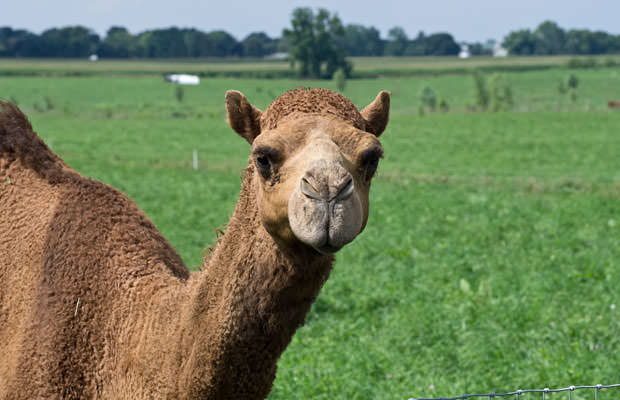The Camel Milk Fad

It used to be that you browsed the dairy aisle to buy milk. Plain ol’ cow milk — and probably from a cow named Betsy. But now, the question is what kind of milk should you buy. After all, you’ve got soy, almond, rice, coconut — and now, the milk from snaggletoothed, hump-day-wailing camels.
Camel Is The New Cow
Long consumed in desert locales where camels roam instead of cows, dromedary milk is becoming increasingly popular in the U.S. This year, California-based Desert Farms launched what it’s calling the country’s first commercially available line of camel milk.
Already available in more than 50 Whole Foods stores throughout California, Desert Farms is starting to be distributed elsewhere.Meanwhile, it’s also available by mail order.
But it doesn’t come cheap. A 16-ounce bottle of raw Desert Farms camel milk will set you back $18. That’s largely because the company gets its milk from a set of seven Midwest camel farmers, and each camel only produces about one to two gallons of milk a day compared to a cow’s twelve.
Similarities And Differences
But, nutritionally speaking, camel milk is really not all that different from 2% fat cow milk, says nutritionist Kelly Pritchett, Ph.D., RD, CSSD, a spokesperson for the Academy of Nutrition and Dietetics, who notes that more research is needed to determine if camel milk can really deliver on its claims.
Meanwhile, cow’s milk packs more protein and less sodium compared to camel milk, which is not surprising since many people claim it tastes salty, and camel milk contain less sugar than cow milk.
There is one big nutritional difference between camel and cow milk, though. The former is typically sold raw rather than pasteurized.
And while skipping pasteurization prevents some nutrients from being destroyed, it also prevents any bacteria lurking in a camel’s udder from being destroyed before being poured into your glass.
For that reason, Pritchett recommends that people with weakened immune systems, newborns and infants, pregnant women, the elderly, as well as people on corticosteroids, antibiotics, or even antacids, should steer clear of raw milk to prevent food-borne illnesses.
Plus, when raw, milk goes bad fast — in as little as three days after its sell-by date, according to Desert Farms. Luckily, though, the company does offer a pasteurized version in case that happens to be where you draw your camel-sipping line.












